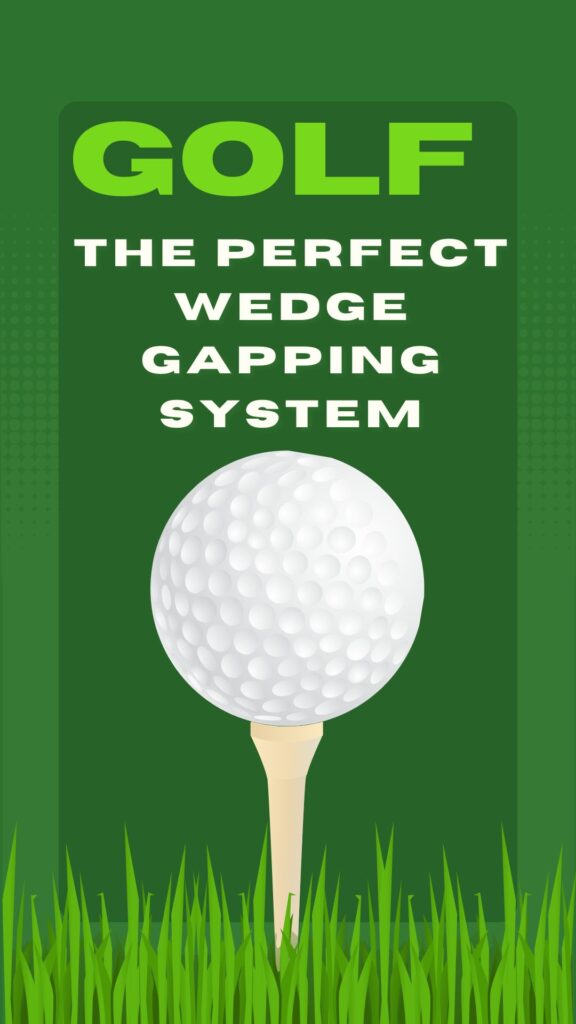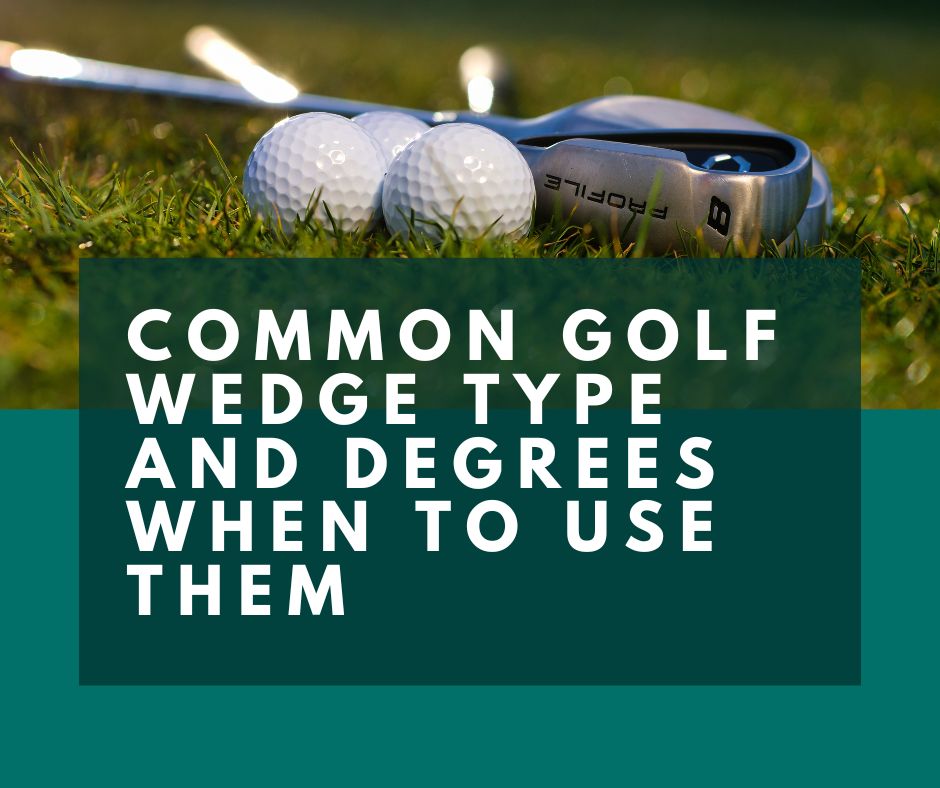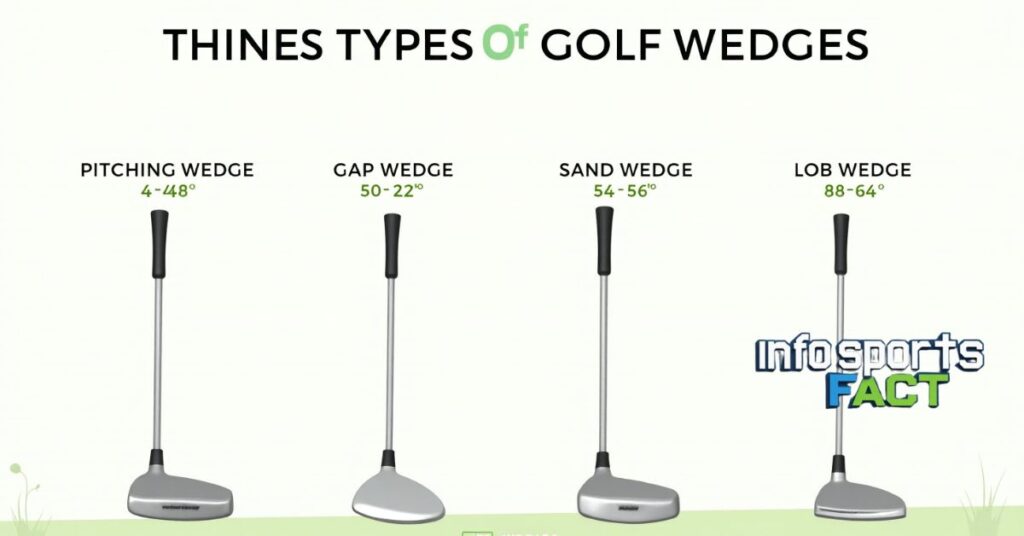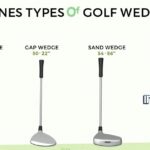Have you ever stood over a shot 80 yards from the green and felt completely uncertain about which golf wedge to pull from your golf bag? You’re not alone. The confusing world of wedge degrees, bounce angles, and specialized wedge types leaves many golfers scratching their heads while their scores suffer.
In this comprehensive guide, we’ll decode everything you need to know about golf wedge types and degrees to transform your short game from a weakness into a weapon. Whether you’re a high handicapper seeking more consistency or a low handicapper looking to add versatility around the greens, you’ll discover exactly which wedges belong in your bag and how to use them effectively.
Understanding the Golf Wedge Family: Your Scoring Arsenal
Let’s start with the basics. Golf wedges aren’t just clubs—they’re precision instruments designed for specific situations. The five main types form a progression of increasing loft that gives you options for virtually any shot around the green.

Pitching Wedge (PW): The Versatile Foundation
The Pitching Wedge (PW) serves as your introduction to the wedge family, with loft degrees typically ranging from 44-48°. It’s the most versatile wedge in your arsenal and the one you’ll likely use most frequently.
“The pitching wedge is the bridge between your iron set and your specialized wedges. Master this club first, and the others will make more sense.” – Phil Mickelson
Key characteristics of the Pitching Wedge:
- Loft range: 44-48° (trending stronger in modern sets)
- Typical distances: 110-130 yards for men, 70-90 yards for women
- Primary uses: Full approach shots, standard chips, bump-and-runs
- Bounce: Usually mid-range (6-8°)
Worth noting: Modern golf club manufacturers have been “strengthening” lofts across their iron sets, meaning today’s PWs often have lofts closer to 44° compared to the traditional 48°. This “loft creep” creates distance gaps that need addressing with additional wedges.
Gap Wedge (GW) and Approach Wedge (AW): The Distance Fillers
The Gap Wedge (GW) and Approach Wedge (AW) are essentially the same club with different names depending on the manufacturer. This wedge emerged to fill the growing distance gap between pitching and sand wedges as PW lofts strengthened.
Key characteristics of the Gap/Approach Wedge:
- Loft range: 48-52°
- Typical distances: 90-110 yards
- Primary uses: Controlled shots from awkward distances, three-quarter swings
- Bounce: Typically mid-range (8-10°)
Many beginner’s golfer sets now include an AW as standard equipment, recognizing its critical importance for distance control.
Sand Wedge (SW): The Bunker Specialist
The Sand Wedge (SW) was initially designed specifically for bunker play but has evolved into a versatile tool for many short game situations.
Key characteristics of the Sand Wedge:
- Loft range: 54-58° (most commonly 56°)
- Typical distances: 70-90 yards
- Primary uses: Bunker escapes, pitch shots, greenside chips from rough
- Bounce: Usually high (10-14°)
The higher bounce angle of the SW is its defining feature. The bounce helps the club glide through sand without digging, making it perfect for bunker play and shots from soft turf.
Lob Wedge (LW): The High-Flying Specialist
The Lob Wedge (LW) is your go-to club for high-trajectory shots with minimal roll, often used to clear hazards or stop the ball quickly on fast greens.
Key characteristics of the Lob Wedge:
- Loft range: 58-64° (most commonly 60°)
- Typical distances: 40-65 yards
- Primary uses: Flop shots, delicate shots over obstacles, steep-angle approaches
- Bounce: Variable, but often lower (4-8°) for versatility
The LW requires the most skill to use effectively but can produce spectacular results in the right hands. Many pros even carry multiple lob wedges with different bounces for various conditions.
The Science of Bounce: Understanding the Critical Second Angle
Bounce might be the most misunderstood aspect of wedge design, yet it’s arguably as important as loft. The bounce angle is measured between the leading edge of the club and the lowest point of the sole.

Bounce Categories and Their Ideal Uses
| Bounce Type | Angle Range | Ideal Conditions | Swing Type Match | Best For |
| Low bounce | 4-6° | Firm turf, tight lies, hard sand | Shallow swing | Players who sweep the ball |
| Mid bounce | 6-10° | Average conditions, normal fairways | Neutral swing | Most versatile, all-around play |
| High bounce | 10-14° | Soft turf, fluffy lies, bunkers | Steep swing (angle of attack) | Players who take divots |
How Bounce Affects Your Contact Quality
The right bounce for your game dramatically improves your contact quality. Too little bounce for your swing type and conditions, and your wedge will dig and create fat shots. Too much bounce, and the leading edge may sit too high, causing thin shots that sail over the green.
Wedge Selection Strategy by Handicap Level
Your optimal wedge setup depends largely on your skill level and playing style. Let’s break down recommendations by handicap:
High Handicapper Wedge Strategy (18+ Handicap)
For high handicappers, simplicity and forgiveness should be the priority. Fewer wedges with more versatility will serve you better than specialized tools you aren’t ready to maximize.
Recommended setup:
- Pitching wedge (part of your iron set)
- Gap/Approach wedge (50-52°, mid bounce)
- Sand wedge (56°, high bounce)
This three-wedge system gives you enough options without overwhelming you with decisions. The high bounce sand wedge provides maximum forgiveness on mishits and helps tremendously in bunkers.
Focus on:
- Developing consistent distance control with your PW
- Learning basic bunker play with your SW
- Using your GW/AW for awkward distances between the two
Mid-Handicapper Wedge Strategy (8-17 Handicap)
As your shot control improves, you can start exploring more specialized options.
Recommended setup:
- Pitching wedge (part of your iron set)
- Gap wedge (50-52°, mid bounce)
- Sand wedge (54-56°, mid-to-high bounce)
- Lob wedge (58-60°, mid-to-low bounce)
This four-wedge system provides comprehensive coverage for most situations. The addition of a lob wedge allows for more creative short game options.
Focus on:
- Developing half and three-quarter shots with each wedge
- Practicing flop shots for situations when you need them
- Experimenting with different bounce angles to find your preference
Low Handicapper Wedge Strategy (0-7 Handicap)
For low handicappers, wedge selection becomes highly personalized based on your playing style, home course conditions, and specific shot preferences.
Recommended setup:
- Pitching wedge (part of your iron set)
- Gap wedge (50°, bounce based on preference)
- Sand wedge (54°, mid-to-high bounce)
- Lob wedge (58°, bounce based on preference)
- Optional second lob wedge (60-64°, specialized bounce)
The key for better players is precise loft gapping (typically 4° between each wedge) and bounce configurations that match your tendencies and regular playing conditions.
Focus on:
- Developing precise yardages for full, 3/4, 1/2, and 1/4 swings with each wedge
- Mastering specialized shots like the high spinner, low checker, and soft flop
- Potentially carrying multiple bounce angle options for different courses
The Perfect Wedge Gapping System
Proper wedge gapping is essential for eliminating awkward distances from your game. The ideal setup should give you predictable yardage gaps between clubs.

The 4-Degree Rule
Most professional fitters recommend approximately 4 degrees of loft separation between wedges. This typically creates 10-15 yard gaps on full shots, allowing for manageable distance control.
For example, a well-gapped modern wedge set might look like:
- Pitching wedge: 44-46°
- Gap wedge: 50°
- Sand wedge: 54°
- Lob wedge: 58°
Building Your Distance Control Chart
Create a personal wedge distance chart covering full, 3/4, 1/2, and 1/4 swings with each wedge. This visual reference eliminates guesswork when faced with awkward distances.
Common Golf Wedge Type and Degrees When to Use Them
Different situations call for different wedge shots. Here’s a quick guide to the major shot types and which wedges excel at each:

Full Shots: Maximum Distance with Control
Best wedges: PW, GW/AW Technique: Complete backswing and follow-through When to use: When you need maximum distance while still stopping the ball
Pitch Shots: Medium Height with Moderate Roll
Best wedges: GW/AW, SW Technique: Abbreviated backswing, controlled follow-through When to use: From 20-50 yards when you have room to let the ball run
Chip Shots: Low Flight with More Roll
Best wedges: PW, GW/AW Technique: Minimal wrist action, more putting stroke When to use: Around the green when you have plenty of green to work with
Flop Shots: Maximum Height with Minimal Roll
Best wedges: SW, LW Technique: Open face, active wrists, accelerating swing When to use: When you need to clear an obstacle or stop the ball quickly
Bunker Shots: Explosion from Sand
Best wedges: SW, LW Technique: Open stance, open face, hit the sand behind the ball When to use: Any time you’re in a bunker
Frequently Asked Questions About Golf Wedge Types and Degrees
What’s the real difference between an Approach Wedge (AW) and a Gap Wedge (GW)?
There’s virtually no difference—they’re two names for the same club. The term “Approach Wedge” is more commonly used by manufacturers when including this club in iron sets, while “Gap Wedge” tends to be used for wedges sold separately. Both typically have loft degrees between 48-52°.
How do I choose the right golf wedge degrees for my game?
Start by knowing your pitching wedge loft, then create approximately 4-degree gaps between your wedges. Consider your typical playing conditions and skill level:
- High handicappers should prioritize forgiveness with fewer wedges
- Mid handicappers benefit from a standard four-wedge set (PW, GW, SW, LW)
- Low handicappers might consider specialized gapping and bounce options
The most important factor is eliminating large distance gaps in your short game.
How does golf wedge bounce affect my game?
Bounce angle affects how your wedge interacts with the turf or sand. It’s crucial to match bounce to:
- Your swing style (steep vs. shallow)
- Typical course conditions (soft turf vs. firm turf)
- The types of shots you frequently face
Here’s a simple rule of thumb:
- If you take divots or play on soft courses, lean toward higher bounce
- If you sweep the ball or play on firm courses, consider lower bounce
- When in doubt, mid-bounce offers the most versatility
Should my wedges match my iron set or be specialized?
For high handicappers, set-matching wedges often provide more consistency and forgiveness. As you improve, specialized wedges offer more versatility and performance benefits for specific situations.
Many low handicappers use their set’s pitching wedge but add specialized gap, sand, and lob wedges from wedge-focused manufacturers.
Advanced Wedge Considerations
Materials and Finishes
Most premium wedges are made from soft carbon steel for enhanced feel, while more durable stainless steel options provide longevity at the expense of some feedback.
Popular finishes include:
- Chrome: Durable, traditional look
- Black: Reduced glare, modern appearance
- Raw/unplated: Superior rust development for increased friction (but shorter lifespan)
Groove Technology
Wedge grooves wear faster than any other club in your bag, affecting spin and control. Consider replacing your wedges every 75-100 rounds if you play and practice frequently.
Modern groove designs maximize spin within the rules of golf, with various patterns optimized for different conditions.
Wedge Practice Strategies to Lower Your Scores
The best wedge setup in the world won’t help if you don’t know how to use it. Here are focused practice drills to improve your wedge game:
Clock-Face Distance Control
Set up at the practice green and imagine standing in the center of a clock. Hit wedge shots to different “hours” on the clock, varying distances with the same club by controlling your swing length.
Trajectory Training
Practice hitting three different trajectories with each wedge:
- High: More ball-back in stance, hands neutral
- Medium: Ball center, hands slightly forward
- Low: Ball forward, hands significantly forward
Bunker Ladder Drill
In a practice bunker, place five balls in a line leading away from your target. Try to hit each progressively further, controlling distance by adjusting your swing length rather than power.
Conclusion: Building Your Ideal Wedge Arsenal
Your wedge setup should evolve as your game improves. Start with the basics—a pitching wedge, gap wedge, and sand wedge—and add specialized options as your skills and understanding develop.
Remember that the right wedges aren’t just about the clubs themselves but how they fit your:
- Swing style
- Home course conditions
- Skill level
- Shot preferences
With proper selection and practice, your wedges will transform from confusion-causing clubs into precision scoring tools that lower your scores and increase your enjoyment of the game.

Mary Siegel is an experienced blogger at Info Sports Fact, specializing in delivering insightful and engaging sports content. With a passion for uncovering facts and trends across various sports, she brings clarity and depth to every post.




